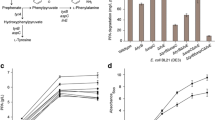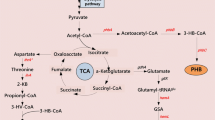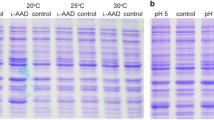Abstract
D-p-hydroxyphenylglycine (D-HPG) is a widely used intermediate for the synthesis of semi-synthetic antibiotics. It can be produced from DL-5-p-hydroxyphenylhydantoin through two sequential enzymatic reactions catalyzed by D-hydantoinase and N-carbamoylase. However, the low productivity and high production cost of the current process significantly limit its industrial application. To set up an efficient and cost-effective whole-cell bioconversion process for D-HPG production, a recombinant E. coli strain was constructed by co-expressing D-hydantoinase and N-carbamoylase from Agrobacterium sp. Then a cheap medium formulation, which uses glycerol and corn steep liquor (CSL) as carbon and nitrogen sources and without addition of any foreign inducer, was developed for high level of enzyme expression. Galactose, melibiose, and raffinose in CSL were found to be capable of inducing T7 promoter. Moreover, this CSL-containing cheap medium exhibited higher expression levels than the traditional LB+IPTG medium for several different enzymes tested, indicating that this medium might be a better alternative to the commonly used LB+IPTG medium for enzyme expression under the control of a T7 promoter. Further optimization revealed that low expression temperature not only increased enzyme expression, but also stabilized the enzyme-expressing cells and the plasmids therein. Wholecell bioconversion was carried out in 55 t water containing 1.8 t substrate and the resting cells expressed in 40 t medium. The specific D-HPG productivity reached 1.68 g/h/g dry cell weight, with a molar yield of 97.8%. To the best of our knowledge, this is the highest productivity reported to date and the first description of this process using large-scale production.
Similar content being viewed by others
References
Ogawa, J. and S. Shimizu (1999) Microbial enzymes: New industrial applications from traditional screening methods. Trends Biotechnol. 17: 13–21.
Kim, G. J. and H. S. Kim (1995) Optimization of the enzymaticsynthesis of D-p-hydroxyphenylglycine from DL-5-substituted hydantoin using D-hydantoinase and N-carbamoylase. Enz. Microb. Tech. 17: 63–67.
Runser, S., N. Chinski, and E. Ohleyer (1990) D-p-Hydroxyphenylglycine production from DL-5-Para-hydroxyphenylhydantoin by Agrobacterium Sp.. Appl. Microbiol. Biot. 33: 382–388.
Olivieri, R., L. Angelini, L. Degen, and E. Fascetti (1981) Microbial transformation of racemic hydantoins to D-amino acids. Biotechnol. Bioeng. 23: 2173–2183.
Yokozeki, K., S. Nakamori, C. Eguchi, K. Yamada, and K. Mitsugi (1987) Optimal conditions for the enzymatic production of D-amino acids from the corresponding 5-substituted hydantoins. Agr. Biol. Chem. Tokyo 51: 355–362.
Moller, A., C. Syldatk, M. Schulze, and F. Wagner (1988) Stereospecificity and substrate-specificity of a D-hydantoinase and a DN-carbamyl-amino acid amidohydrolase of Arthrobacter crystallopoietes Am-2. Enz. Microb. Tech. 10: 618–625.
Ogawa, J., M. C. M. Chung, S. Hida, H. Yamada, and S. Shimizu (1994) Thermostable N-carbamoyl-D-amino acid amidohydrolase: Screening, purification and characterization. J. Biotechnol. 38: 11–19.
Wu, S., L. Yang, Y. B. Liu, G. G. Zhao, J. J. Wang, and W. R. Sun (2005) Enzymatic production of D-p-hydroxyphenylglycine from DL-5-p-hydroxyphenylhydantoin by Sinorhizobium morelens S-5. Enz. Microb. Tech. 36: 520–526.
Jiang, M., L. N. Shang, P. Wei, R. H. Yu, N. Shen, P. K. Ouyang, and H. N. Chang (2007) Pilot-scale production of D-p-hydroxyphenylglycine from DL-5-p-hydroxyphenylhydantoin by Burkholderia cepacia JS-02. Enz. Microb. Tech. 41: 407–412.
Yu, H., S. Yang, W. Jiang, and Y. Yang (2009) Efficient biocatalytic production of D-4-hydroxyphenylglycine by whole cells of recombinant Ralstonia pickettii. Folia Microbiol. 54: 509–515.
Grifantini, R., G. Galli, G. Carpani, C. Pratesi, G. Frascotti, and G. Grandi (1998) Efficient conversion of 5-substituted hydantoins to D-alpha-amino acids using recombinant Escherichia coli strains. Microbiol.-UK 144: 947–954.
Chao, Y. P., H. Y. Fu, T. E. Lo, P. T. Chen, and J. J. Wang (1999) One-step production of D-p-hydroxyphenylglycine by recombinant Escherichia coli strains. Biotechnol. Progr. 15: 1039–1045.
Park, J. H., G. J. Kim, and H. S. Kim (2000) Production of Damino acid using whole cells of recombinant Escherichia coli with separately and coexpressed D-hydantoinase and N-carbamoylase. Biotechnol. Progr. 16: 564–570.
Liu, Y. Q., Q. Li, X. J. Hu, and J. C. Yang (2008) Construction and co-expression of polycistronic plasmid encoding D-hydantoinase and D-carbamoylase for the production of D-amino acids. Enz. Microb. Tech. 42: 589–593.
Ko, Y. M., C. I. Chen, H. C. Chang, H. M. Chen, C. J. Shieh, Y. J. Syu, and Y. C. Liu (2011) Exploring the complex effects of metal ions on D-hydantoinase purification with an immobilized metal affinity membrane. J. Taiwan Inst. Chem. Eng. 42: 735–740.
Hull, S. R., B. Y. Yang, B. Yun, D. Venzke, K. Kulhavy, and R. Montgomery (1996) Composition of corn steep water during steeping. J. Agric. Food Chem. 44: 1857–1863.
Schein, C. H. (1989) Production of soluble recombinant proteins in bacteria. Nat. Biotechnol. 7: 1141–1147.
Sorensen, H. P. and K. K. Mortensen (2005) Soluble expression of recombinant proteins in the cytoplasm of Escherichia coli. Microb. Cell Fact. 4: 1–8.
Author information
Authors and Affiliations
Corresponding author
Rights and permissions
About this article
Cite this article
Zhang, J., Cai, Z. Efficient and cost-effective production of D-p-hydroxyphenylglycine by whole-cell bioconversion. Biotechnol Bioproc E 19, 76–82 (2014). https://doi.org/10.1007/s12257-013-0451-9
Received:
Revised:
Accepted:
Published:
Issue Date:
DOI: https://doi.org/10.1007/s12257-013-0451-9




